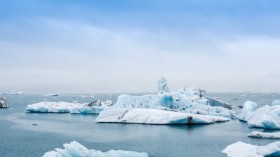With ice sheets and glaciers melting as a result of climate change, global sea level rise has been of major concern to scientists. But not all areas of the world are created equal. New research shows that England and Northern Europe in particular are at risk of major sea level rise in the future - more so than previously thought.
According to the results published in the journal Climate Research, the seas around Scandinavia, England, the Netherlands and northern Germany will rise by up to about 1.5 meters (~5 feet) in this century.
"Even though the oceans are rising, they do not rise evenly across the globe. This is partly due to regional changes in the gravitational field and land uplift," researcher Aslak Grinsted, with the Niels Bohr Institute at the University of Copenhagen, said in a statement.
Gravity over the surface of the land and sea varies due to differences in the subsurface and surroundings - the greater the mass, the greater the gravity. For example, the Greenland Ice Sheet - the second largest ice sheet on Earth - greatly attracts the sea due to its mass. Consequently, the sea level around Greenland becomes higher. But when the ice sheet melts and flows out to sea as water, this attraction is reduced and even though more water has entered the sea, the sea level around Greenland would fall.
"Based on the UN climate panel's report on sea level rise, supplemented with an expert elicitation about the melting of the ice sheets, for example, how fast the ice on Greenland and Antarctica will melt while considering the regional changes in the gravitational field and land uplift, we have calculated how much the sea will rise in Northern Europe," explained Grinsted.
Previous estimates had already indicated that the Netherlands and England would experience significant sea level rise. Now, these latest calculations show that these high scenarios will be surpassed.
"For London, the calculated best estimate is that sea level will rise by 0.8 meters. In England, a sea level rise of more than 0.9 meters in this century has been considered highly unlikely, but our new calculation shows that there is a 27% chance that this limit is surpassed and we cannot exclude a sea level rise of up to 1.75 meters this century," Grinsted said.
For the Netherlands, this study shows there is a 26 percent chance that it will exceed sea level rise of 1.05 meters - the highest scenario projected.
"Both countries have already established protections for the coasts with barriers, sluice gates, and dikes, but is it enough? I hope that our calculations for worst-case-scenarios will be taken into consideration as the countries prepare for climate change," noted Grinsted.
Copenhagen, on the other hand, isn't as worse off. According to the latest results, the best estimate is that sea levels will rise by 0.68 meters, but there is a risk of increases up to 1.6 meters.
On a more positive note, the sea level in the Gulf of Bothnia, Finland is expected to fall by 10 centimeters due to land uplift - that is, the land will rise faster than the sea. That's also despite the fact that global sea levels are predicted to rise by an average of 80 centimeters.
In addition, the reduced graviational attraction of the Greenland Ice Sheet will mean the sea will fall up to 2,000 kilometers (1,242 miles) away from the ice sheet, and that the sea level in Northern Europe is not particularly sensitive to Greenland ice melt. This holds true for places like Ireland, Scotland and Norway, for example.
It remains to be seen what the future will bring, but this and other studies indicate that the sea will most certainly rise. How high, only time will tell. But in the meantime, coastal communities especially should prepare for a "worse-case-scenario," researchers say.
For more great nature science stories and general news, please visit our sister site, Headlines and Global News (HNGN).
© 2024 NatureWorldNews.com All rights reserved. Do not reproduce without permission.





